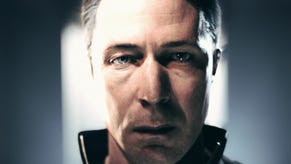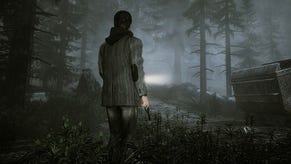Alan Wake
Wake tree arena.
To compound this, Wake's enemies understand self-preservation. If you're staring down multiple opponents, the moment you draw a bead on one of them the others fan out. There's a dodge move, but the quickness of Wake's opponents and their ability to blend in with the darkened woodland is disorientating. Since it only takes around three or four well-placed hits to be killed, you're advised to put as much distance between yourself and attackers as possible.
Alan Wake will never be mistaken for Max Payne, then, but it remains exhilarating and dramatic. You often find yourself running out of bullets, and the gap between Wake and a pack of enemies closes fast. At one point you turn and see a generator next to an unlit outside light, and charge towards it while shadowy attackers hiss and snarl behind you. But when you reach the generator and hit the requested face button, it merely sputters. It takes another attempt to get it going, bathing Wake in glorious yellow light and destroying an attacker only inches away.
Meanwhile the presentation is stunning, caught in a beautiful twilight between ethereal and realistic. The game's story, gameplay and atmosphere all creep into the player's periphery at an elegant pace, but the visuals win you over before you pick up the pad. Remedy's latest adventure is set in the Pacific North West and every item in the environment looks and feels authentic: there's not a vehicle model or a style of building or a piece of vegetation that looks out of place. The team also boasts that the weather, lighting and even the animals on the soundtrack are region-specific, as are the clothing styles and accents of the townsfolk.
The game also has a trump card in the way its camera blends functionality with cinematic flare, because rather than being glued to every tiny movement the camera is staggered by a split second. This is hardly noticeable when the player is engaged in mundane activities like fiddling with a jukebox or investigating the interior of an unlit house, but when the action kicks into gear it becomes a little more pronounced.
The way Wake almost seems to duck out of shot as the player reacts to a rapid attack feels as though the action on-screen is being filmed by another person. The camera also occasionally unhooks from behind Wake's shoulder to hurtle forward for a reveal shot or a slow-motion close-up track on a hurled weapon. It then returns to its original position swiftly and intuitively with no break in the action.
If a sporadically roaming third-person camera sounds like it might be a pain though, don't worry. Judging by the sections we've played, Remedy doesn't front-load its cinematic effects; if you die, you won't have to sit through a series of pre-programmed scenes before you get back into the action. Rather the game's camera responds to the player's sense of timing; ducking out of the way of a spinning axe at the last minute rewards the player with a slow-motion steady shot, for example.
Alan Wake still has a lot to prove, having gotten lost in the release date woods so frequently that it's impossible to approach it free of scepticism, but the small 45-strong team at Remedy's Helsinki HQ looks to be justifying the slow pace of development. Even after an hour in Wake's company, the game burrows into your head and stays with you long after you've stopped playing it. The more you think about it, the longer its list of accomplishments becomes, and the further away that May release date starts to feel. "A psychological action thriller that contains elements of horror"? It should be worth finding out.
Alan Wake is due out for Xbox 360 on 21st May in Europe.







